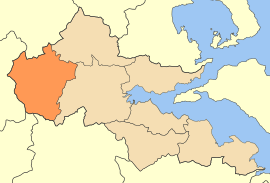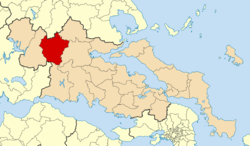Makrakomi
Makrakomi (Greek: Μακρακώμη) is a town and a municipality in the western part of the Phthiotis regional unit, in Greece. The seat of the municipality is the town Spercheiada.[2]
Makrakomi Μακρακώμη | |
|---|---|
 Municipality of Makrakomi within the Phthiotis regional unit | |
 Makrakomi Location within the region  | |
| Coordinates: 38°56′N 22°7′E | |
| Country | Greece |
| Administrative region | Central Greece |
| Regional unit | Phthiotis |
| Area | |
| • Municipality | 836.6 km2 (323.0 sq mi) |
| • Municipal unit | 271.3 km2 (104.7 sq mi) |
| Elevation | 15 m (49 ft) |
| Population (2011)[1] | |
| • Municipality | 16,036 |
| • Municipality density | 19/km2 (50/sq mi) |
| • Municipal unit | 5,617 |
| • Municipal unit density | 21/km2 (54/sq mi) |
| Community | |
| • Population | 2,245 (2011) |
| Time zone | UTC+2 (EET) |
| • Summer (DST) | UTC+3 (EEST) |
| Postal code | 350 11 |
| Area code(s) | 22360 |
| Vehicle registration | ΜΙ |
| Website | www.makrakomi.gr |
Geography
Makrakomi is built on the southern slopes of Western Othrys at an altitude of 280 m. It overlooks the river Spercheios and its valley. Makrakomi is located east of Karpenisi, ENE of Agrinio, south of Karditsa, west of Lamia and the GR-1/E65 and the E75 as well as the GR-3 and WNW of Amfissa. Makrakomi is linked with the GR-38 (Agrinio - Evrytania - Lamia).
Municipality
The Municipality of Makrakomi was formed at the 2011 local government reform by the merger of the following 4 former municipalities, that became municipal units (constituent communities in brackets):[2]
- Agios Georgios Tymfristou (Agios Georgios, Dikastro, Mavrilo, Megali Kapsi, Merkada, Mesaia Kapsi, Neochori, Palaiokastro, Perivlepto, Pitsiota, Ptelea, Vitoli)
- Makrakomi (Archani, Asvesti, Giannitsou, Grammeni, Kastri, Litoselo, Makrakomi, Makri, Palaia Giannitsou, Pappa, Platystomo, Rovoliari, Trilofo, Tsoukka)
- Spercheiada (Agios Sostis, Anatoli, Argyria, Fteri, Gardiki, Kallithea, Kampia, Kanalia, Kloni, Kolokythia, Kyriakochori, Lefkada, Marmara, Mesopotamia, Nikolitsi, Palaiochori, Palaiovracha, Perivoli, Pitsi, Platanos, Pougkakia, Spercheiada)
- Tymfristos
The municipality has an area of 836.564 km2, the municipal unit 271.298 km2.[3] In 2011 the population of Makrakomi municipal unit was assessed as 5,617 (2,825 male, 2,792 female).
Historical population
| Year | Village | Municipal unit | Municipality |
|---|---|---|---|
| 1981 | 2,374 | - | - |
| 1991 | 2,717 | 7,262 | - |
| 2001 | 2,226 | 7,132 | - |
| 2011 | 2,245 | 5,617 | 16,036 |
History, monuments and sights
See Ainis.
Makrakomi: This market town bears the name of the ancient Aenian town "Makra Kome" [Long Town] whose ruins can be seen on the small hill Profitis Ilias. "Makra Kome" is mentioned by the historian Livy (Titus Livius) in his description of the destruction of Sperchias by the Aetolians (198 B.C) (see Macra Come). The little church of Agia Paraskevi (set in an overgrown site with cypress trees), the Acropolis of Makrakomi (which affords a splendid view over the plain) and the hillock of Lavanitsa are all worth visiting.
Platistomo: A picturesque bath town with natural springs (known to ancient Aenians). The waters of these springs are recommended for stomach and skin ailments. This place is set in lush vegetation where the traveller can find peace and escape everyday reality under the shade of ancient plane trees.
Nea and Palea Gianitsou - Papas: There are traces of two ancient castles in this location.
Makri: It features a particularly beautiful square and the superb plane-tree wood of the River Spercheios. The only station for nursing and protecting animals in Phthiotis is also located in Makri. The Greek Army general Ioannis Zisis was born at Makri in 1888.
Archani: A place where we can wander off down the ravine with its springs and therapeutic waters.
Asvestis : It has a vaulted bridge made of stone.
Trilofo: It features a religious museum "I Vivlos" ["The Bible"].
Kastri: It has a splendid plane-tree forest on both sides of the Spercheios. The Castle is the most prominent building at the village centre.
Tsouka: The porch of Western Phthiotis. It features a fountain in the "chalkia gourna" ["brass basin"] while there are huge oak trees at Agios Giannis.
Litosselo: There is a Folklore Museum and a settlement called "Afentika" ["The Bosses"].
Rovoliari: There are beautiful ancient fir-trees, chestnut-tree woods and oak-tree woods, as well as, a superb Folklore Museum.
Food and entertainment
Local meat from free range animals and delicious sausages traditionally produced. Wine and raki from the mountainous vineyards of Makrakomi, Tsouka and Platistomo. Famous local produce includes kiwi berries from Kastri and shelled peanuts from Makri. The taverns and restaurants in Makrakomi and the surrounding villages serve kokoretsi, splinantero, kontosouvli (skewered and grilled meats) and other local specialities.
Cultural and other events
Organized events in commemoration of the Battle of Makrakomi; three-day Carnival festivities in Makrakomi. Traditional festivals in Makrakomi (on Agiou Pnevmatos Day [Holy Ghost]) and all the other villages. Music nights, dedicated events, exhibitions and theatricals are also put on in summer.
See also
References
- "Απογραφή Πληθυσμού - Κατοικιών 2011. ΜΟΝΙΜΟΣ Πληθυσμός" (in Greek). Hellenic Statistical Authority.
- Kallikratis law Greece Ministry of Interior (in Greek)
- "Population & housing census 2001 (incl. area and average elevation)" (PDF) (in Greek). National Statistical Service of Greece. Archived from the original (PDF) on 2015-09-21.
